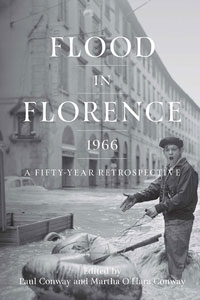
Flood in Florence, 1966: A Fifty-Year Retrospective
Skip other details (including permanent urls, DOI, citation information): This work is licensed under a Creative Commons Attribution-NonCommercial-NoDerivatives 4.0 International License. Please contact mpub-help@umich.edu to use this work in a way not covered by the license.
For more information, read Michigan Publishing's access and usage policy.
The Florence Flood and Its Aftermath: The Photography of Balthazar Korab
It was daybreak on November 4, 1966, when the Arno River began to reveal its true destructive potential to the waking inhabitants of Florence. The rising depth and increased velocity of the river were to be expected given the extraordinary amount of rainfall that had soaked northern and central Italy throughout the month of October. However, it was the makeup of contents swirling in the river that signaled the severity of destruction inflicted upon towns upstream and foreshadowed the devastation about to be unleashed on the Florentines and their city. At first, the debris was seemingly innocuous, a typical mix of detritus one would expect to see floating in a swelling river: tree branches, leaves, litter, and the grimy froth that surfaces in a rapid flow. But it was not long before the river began to deliver a more ominous mix of wreckage: household items, furniture, fuel tanks, and the occasional bovine carcass.[1]
Up in the hills of Settignano, a small town northeast of Florence, news of the raging Arno brought a different kind of urgency to a Hungarian American photographer who was still settling into his apartment after arriving in Italy with his wife and two young children only ten days prior. His working knowledge of Italian was good enough to decipher the periodic radio broadcasts delivering updates on the intense situation unfolding in the city center. And while he had arrived in Italy without any commissioned projects planned for his year-long “sabbatical,” that morning, he knew where he needed to be. So he quickly packed his medium format Hasselblad camera, a 35 mm Leica, and whatever film he had—five rolls of 120 format film (twelve exposures each) and a handful of 35 mm Kodachrome rolls—and convinced his wife to drive him down to the city center, or as near as they could get in their Fiat Cinquecento.
Approaching from the east, they made a circuitous path to the northwest corner of the city, where he disembarked the car in the vicinity of the Fortezza da Basso and the Santa Maria Novella train station. Leaving him behind, his wife was forced to plot a different path back to Settignano—one that entailed numerous harrowing turns including a heartrending drive along the raised bed of a rail line in order to avoid the rising waters. She would later admit that she was not certain she would ever see her husband again.[2]
From Budapest to Florence by Way of the United States: A Brief Introduction to Balthazar Korab
Balthazar Korab was born in Budapest, Hungary, in 1926 and spent his early childhood in a stable upper-middle-class household, benefitting from his daily interactions within a culturally rich capital city.[3] By the time he reached his adolescence, he was well aware of his own advanced artistic skills and declared his desire to pursue a career as a painter. His parents, however, encouraged him to parlay his talents into a more “respectable” career in architecture, as his uncle had done before him. However, his plans to pursue a degree in architecture were interrupted during the German occupation of Hungary in March 1944. By October, the Russian army was advancing west, with the occupying German forces determined to defend Budapest at all costs. So the Korab family packed their essential belongings in two horse-drawn wagons and fled the city. Among his most essential personal items, Korab packed a sketchbook and a Russian-made 35 mm Leica camera that his father purchased from a soldier retreating from the eastern front.
It is important to emphasize that Korab’s artistic sensibilities were maturing at a time of great turmoil in his home city and country, and he used his skills in visual representation to grapple with the disruptive events in his life. It was also during this time that he began to experiment with photography. The majority of his earliest photographs are somewhat casual snapshots of his family and fellow refugees. However, several of his photographs from this period seem to originate from a different kind of perceptual sensitivity—one that deepened Korab’s emotional response to his extraordinary circumstances. This use of visual representation as a coping mechanism to make sense of the dramatic experiences in his life helped shape Korab’s overall “habits of depiction” that would prove instrumental for his future practices as a photographer of architecture.[4]
Korab began his architecture education at the Budapest Polytechnic in 1945, shortly after the end of the Second World War. His time in the university coincided with the Soviet occupation of Hungary and major political upheavals that led to the unjust imprisonment of his father in 1948. Shortly after his father’s release, Korab fled the country in January 1949 with his younger brother (Antoni) and a friend from architecture school (László Kollár). He eventually traveled to Paris, where he was accepted into the architecture program at the École des Beaux-Arts and completed his architecture training (1950–54). He obtained his diploma of architecture in 1954 and then moved to the United States with his first wife, Sally Dow, an American pianist whose family lived outside Detroit.
Soon after his arrival in the United States, Korab sought and was offered a job as a designer in the architecture office of Eero Saarinen and Associates. However, it was his skill with a camera that quickly caught the attention of Saarinen and the senior associates, and before long, he was responsible for integrating photography into the firm’s design-development and documentation processes. Due largely to positive reception of his published photography from his time in the Saarinen office, Korab began to receive numerous professional commissions from other architects throughout the United States and eventually opened an independent photography studio in 1958.
By the early 1960s, Korab’s reputation continued to grow as he became one of the most sought-after professional photographers of architecture, and in 1964, he was awarded first prize in the national competition for the American Institute of Architects’ (AIA) Gold Medal for Excellence in Photography. It was during this time of intense professional development that Korab and his second wife, Monica (née Kane), decided to take a self-imposed one-year sabbatical to Italy, beginning in the fall of 1966, with their children, Christian (b. 1960) and Alexandra (b. 1964). While Korab went to Italy with no grand plan, the opportunity proved to have an enormous influence on his career and personal development as a photographer, as he produced a series of portfolios and publications that contain some of the most historically significant images in his archive.
L’Aqua Alta
Korab’s trek through the flooding city began as he moved cautiously through the dense network of streets in the Santa Maria Novella neighborhood leading to Via de’ Tornabuoni and the Piazza Santa Trinita. From there, he ventured across the Ponte Santa Trinita to the Lungarno Guicciardini along the south bank of the Arno to gain a sweeping view back of the city center at a time when the Arno had reached its most violent levels of intensity and force.
Realizing that he was moving dangerously close to the lower ground in the Santo Spirito and Borgo San Jacopo neighborhoods of “Oltrarno” (beyond the Arno), he headed back across the river in the direction of Santa Maria Novella and continued to venture north into the San Marco neighborhood.
As the high waters continued to flood the city streets farther to the north from the Arno, Korab found himself navigating the historic center of the city by first heading east toward Piazza Santissima Annunziata. Blocked by chest-high waters, he backtracked and moved south down Via Ricasoli in the direction of the Piazza del Duomo, ultimately arriving at the heart of the city’s religious center: between the steps of the Cattedrale di Santa Maria del Fiore (the Duomo) and the Battistero di San Giovanni (the Baptistery of Saint John).
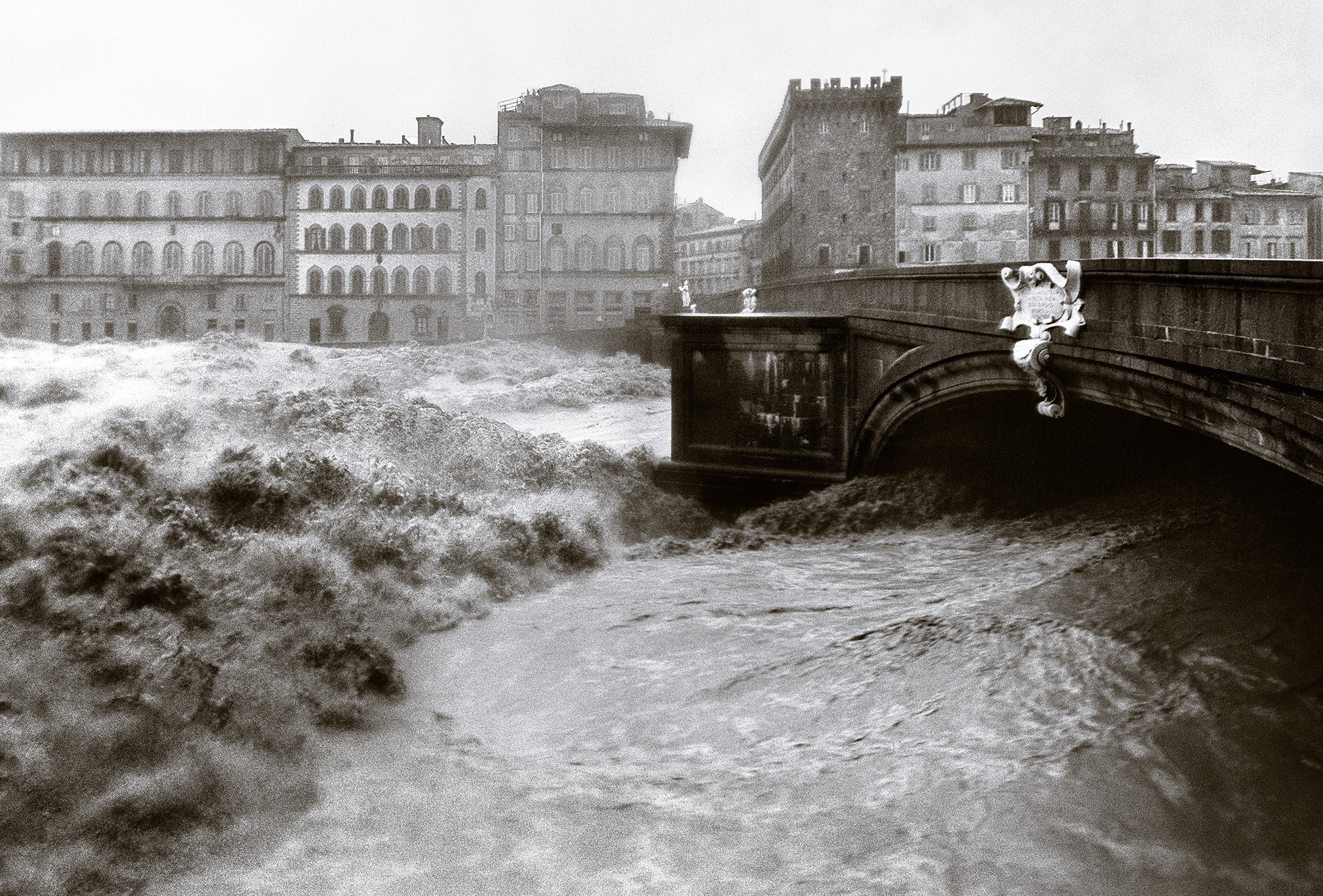
At times submerged up to his chest, Korab moved through the frigid waters to capture some of the most extraordinary images of the flood and its immediate aftermath. The next morning, he drove to Rome to process the film and prepare the images for distribution through organizations such as the Associated Press news service and Life magazine, which purchased the rights for several images for a feature article on the flood that was published two weeks later.[5]
During the days and weeks immediately following the flood, Korab spent much of his time in the city documenting the damage to the city’s architecture, monuments, and works of art, as well as the numerous professionals, students, and volunteers from around the world who traveled to Florence to aid in the conservation efforts focused on the most precious archival materials from the Galleria degli Uffizi, the Istituto e Museo di Storia della Scienza (Institute and Museum of the History of Science; now the Museo Galileo), and the Biblioteca Nazionale Centrale di Firenze (Florence National Central Library).
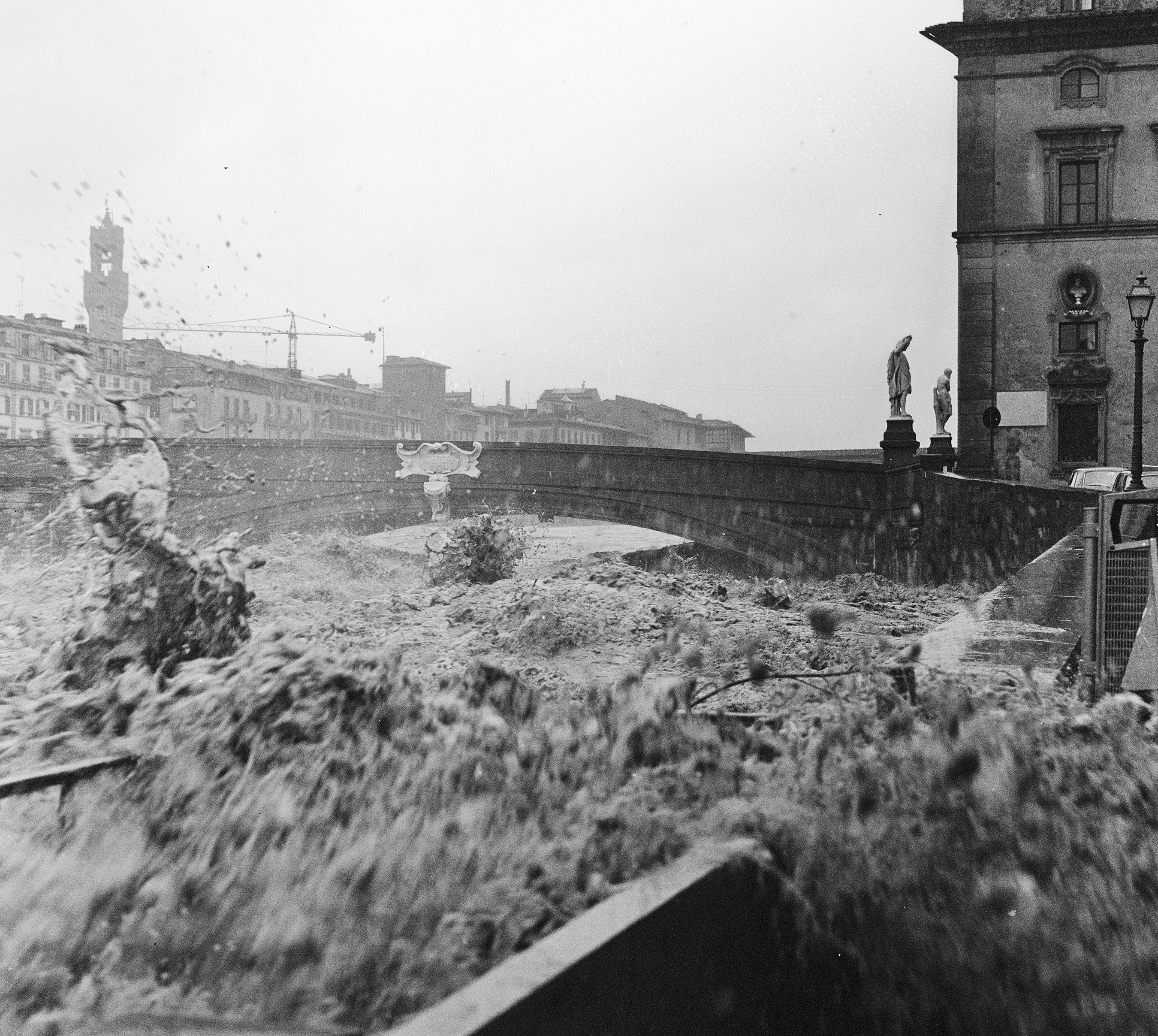
Due largely to the publication of images made during and in the aftermath of the flood, Korab received a plum commission by National Geographic to record the restoration and conservation efforts to repair damaged art and rare books from churches, galleries, libraries, and other archives throughout the city.[6]
This commission from National Geographic helped establish numerous connections between Korab and leaders of the city’s major cultural institutions, including the Uffizi and the National Central Library, who enlisted Korab to aid in the process of cleaning, restoring, and organizing the many thousands of photographic plates and archival transparencies held in their respective collections. The Korabs had moved from their small apartment in Settignano to a flat on the Villa I Tatti estate, which gave them rare access to the gardens and the limonaia. With the help of his family, Korab fashioned a series of drying racks made of bamboo harvested from the gardens to assist in the cleaning and drying of the rare archival photographic plates.

Blocked by chest-high waters, he backtracked and moved south down Via Ricasoli in the direction of the Piazza del Duomo, ultimately arriving at the heart of the city’s religious center: between the steps of the Cattedrale di Santa Maria del Fiore (or the Duomo) and the Battistero di San Giovanni (the Baptistery of Saint John).
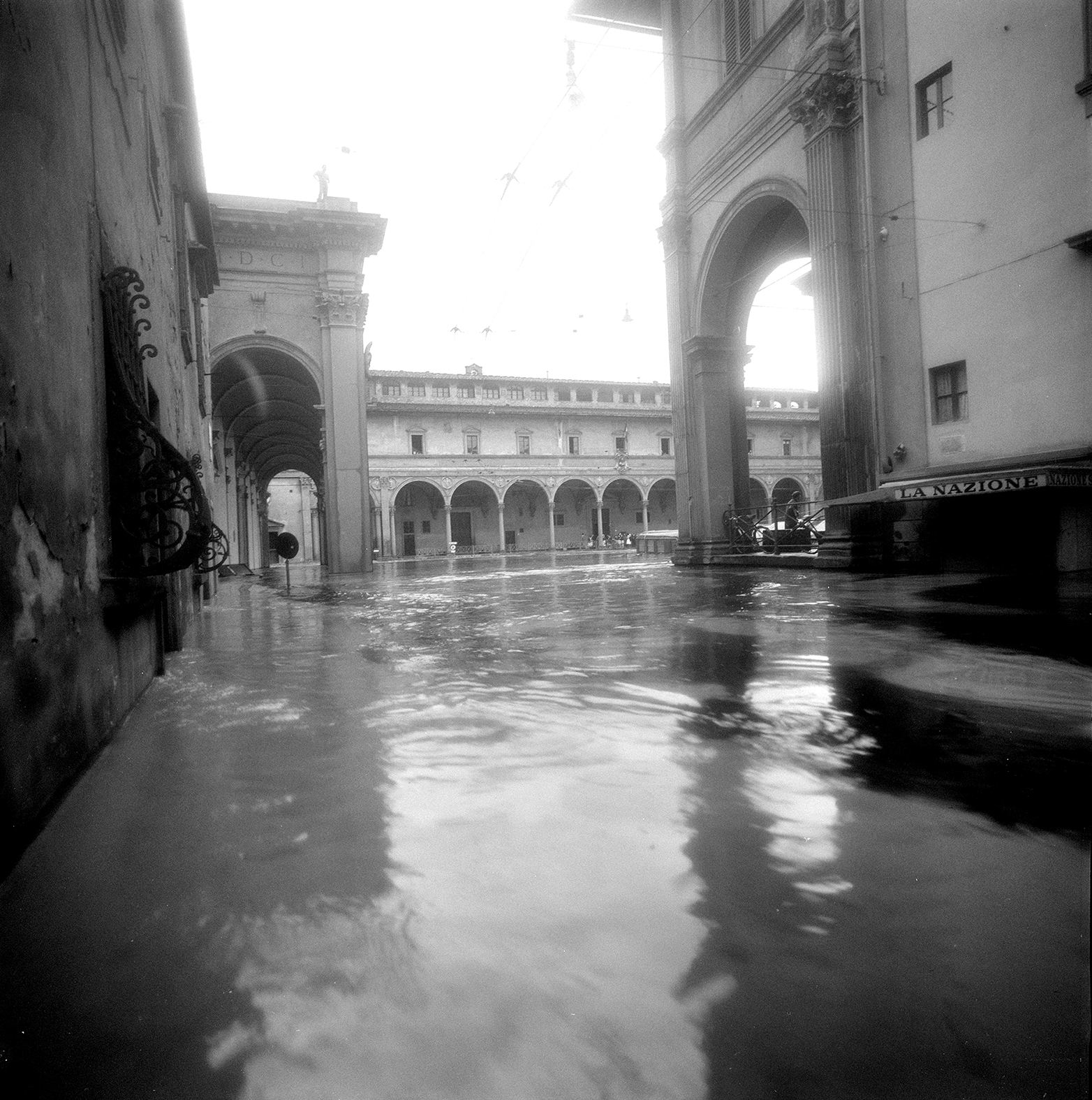
Luisa Becherucci, director of the Uffizi; Professor Ugo Procacci, superintendent of fine art for the Florence region; and Umberto Baldini, director of restorations at the Uffizi all met with Korab frequently throughout his documentation of the restorations being undertaken by their respective institutions.[7]

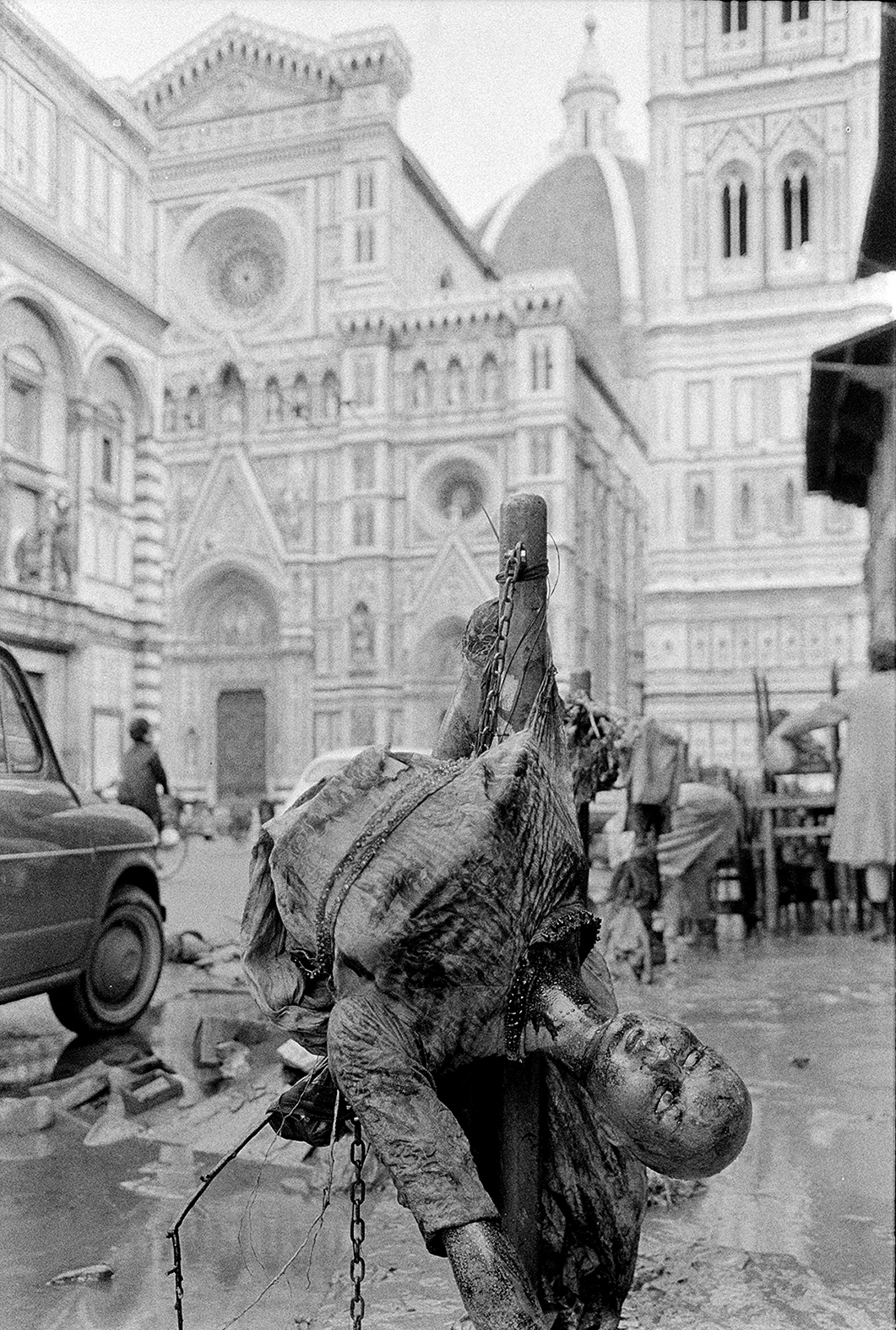
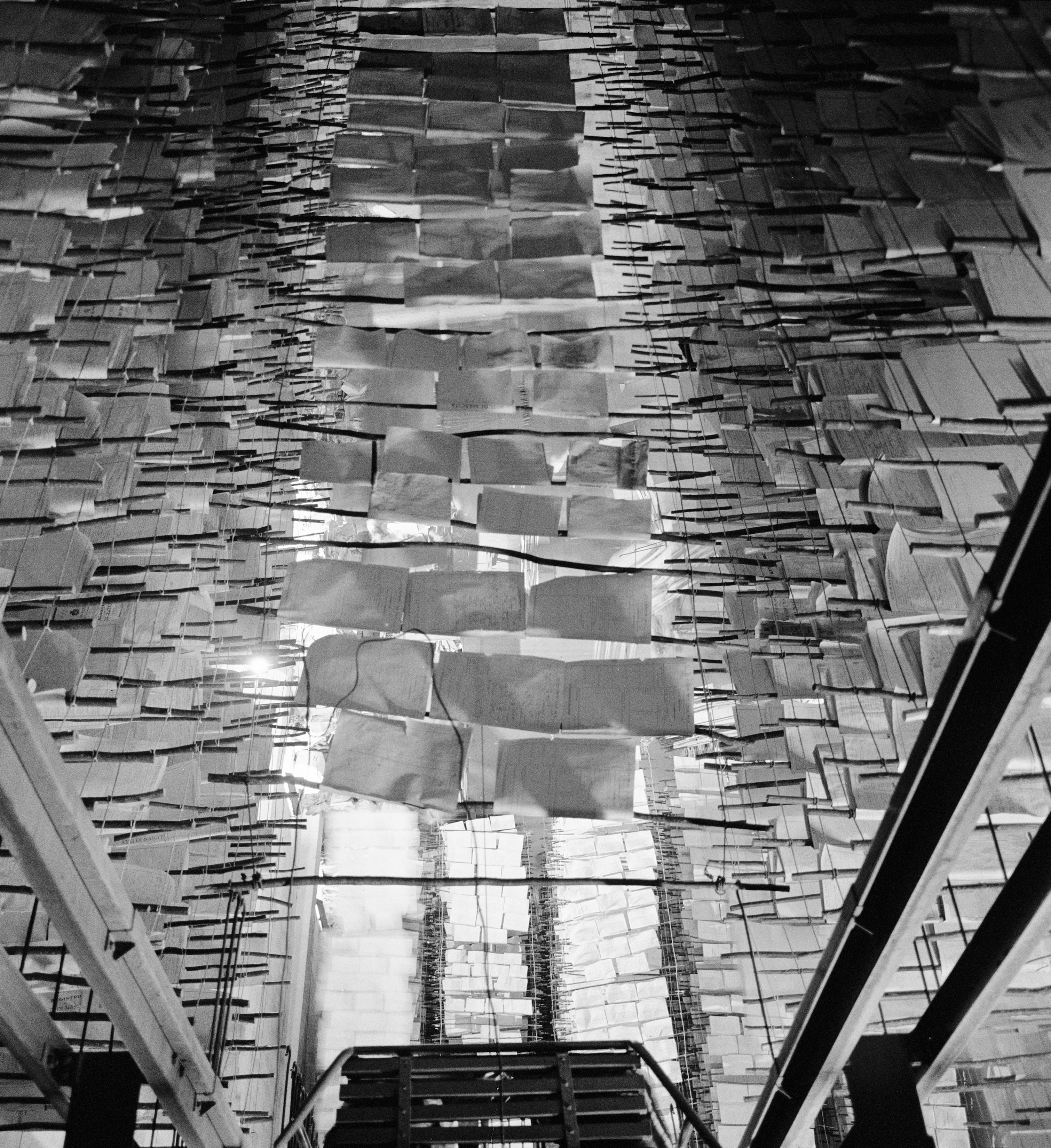
In addition to providing Korab with the rare opportunity to document the historically significant restoration practices developed following the floods, these commissions secured from international publications also created an unanticipated source of income, allowing the Korabs to extend their sabbatical in Italy for an additional year.[8] During the remainder of their stay, Korab produced several other significant portfolios, including one of the gardens at the Villa Gamberaia, another of the working landscapes and hill towns of Tuscany and Umbria, and a unique collaboration with Astra Zarina, an acquaintance from Michigan, documenting the roofscapes of Rome.[9] In what proved to be an extraordinarily expansive survey, Korab produced an estimated 3,200 images, 226 of which were later selected for publication in a book, I tetti di Roma: Le terrazze—le altane—i belvedere (The rooftops of Rome: Terraces—high loggias—overlooks).[10]
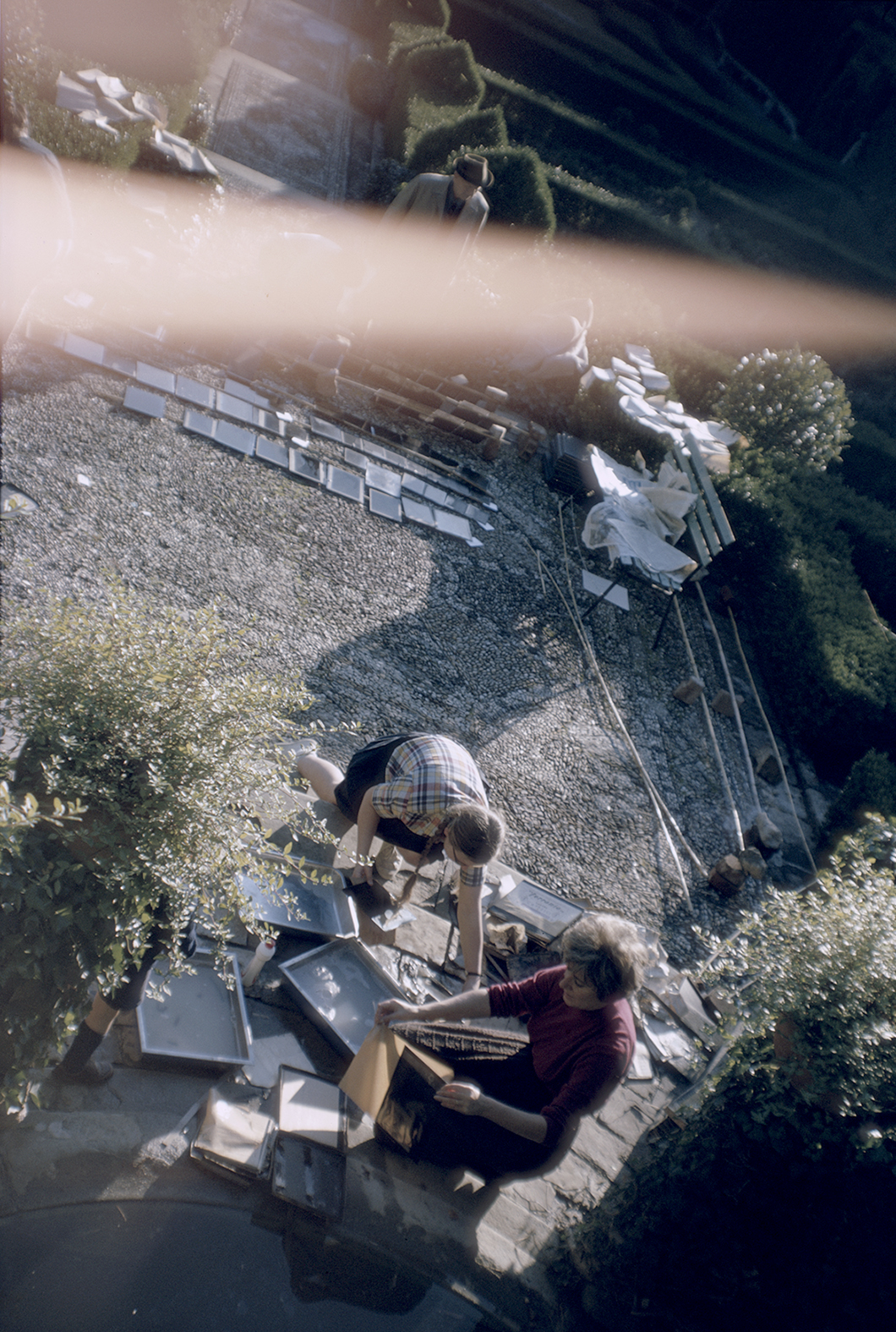
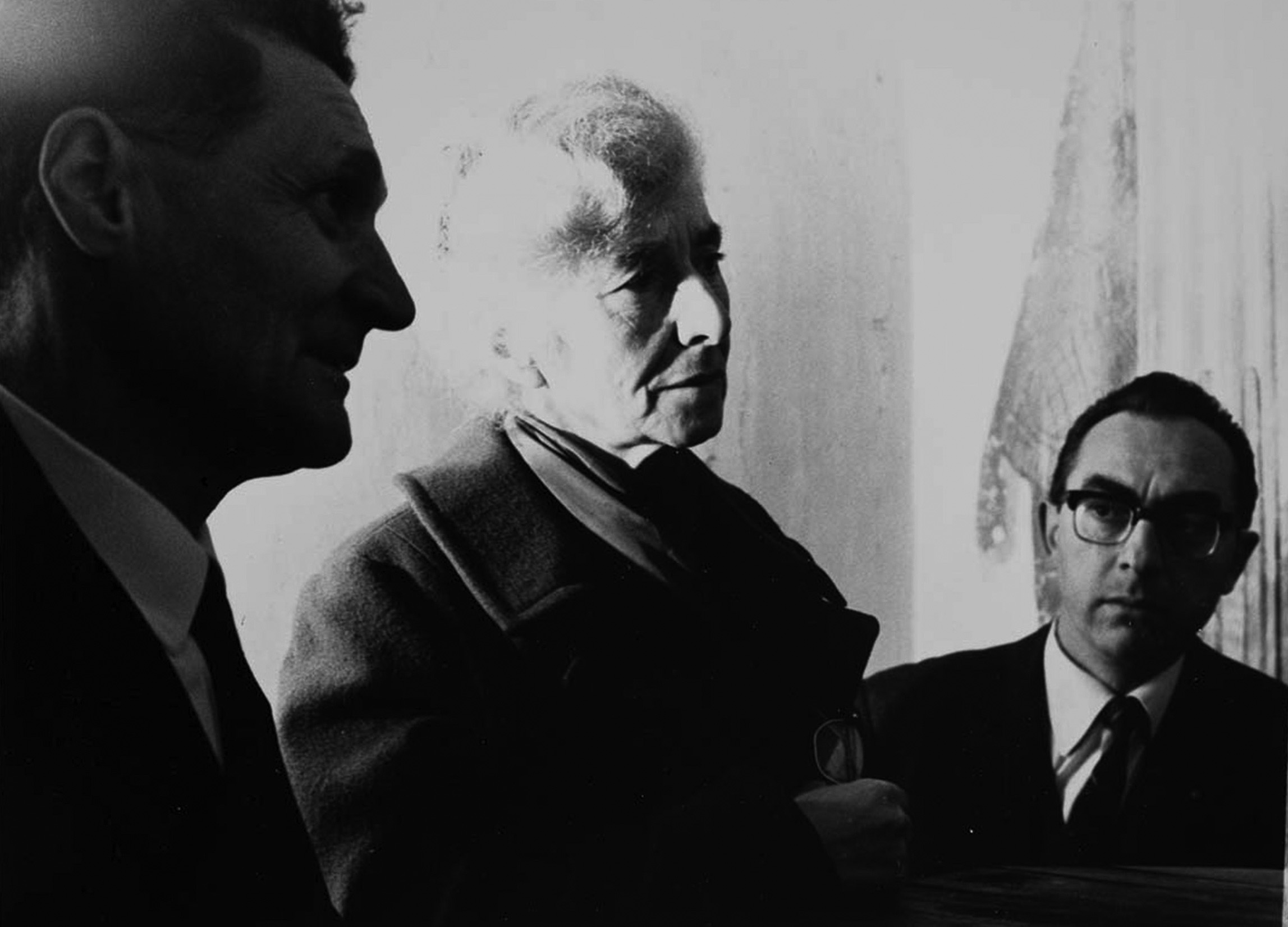
Conclusion
As these proceedings aim to take stock of the progress made in the intervening decades, Balthazar Korab’s photography is both visual evidence and illustrative context for the work of this important symposium. On November 4, 1966, in a matter of hours, the city of Florence and its inhabitants experienced one of the most sublimely horrific and transformative events in its millennia of existence. Today, fifty years on, the city and many of its most treasured artifacts still carry scars from the events of that fateful day.
Having lived a mostly transient life and borne witness to the ravages of war on the built environment, Balthazar Korab came to understand cities as much more than merely collections of static buildings, monuments, spaces, and artifacts. For him, cities made manifest the material, cultural, and historical circumstances that comprise the long arcs of history and the contingencies of the everyday. As his life and career progressed, Korab learned to redirect his technical capacities outward, beyond his personal interests and preoccupations, in order to help capture and understand the complex relationships between architecture and the human condition. In Florence, he broke through to produce images not just of the world but for the world.
Notes
1. For a detailed personal account of the details and events of the Florence Flood, see Kathrine Kressmann Taylor, Diary of Florence in Flood (New York: Simon and Schuster, 1967), 99–100. See also Victor Velen, “Ravaged Realm of Art,” Life, November 18, 1966, 122–23; and Joseph Judge, “Florence Rises from the Flood,” National Geographic, July 1967, 1–43, both of which feature photography by Balthazar Korab.
2. Monica Korab, interview with author, November 11, 2006.
3. For a more detailed biography on the life and career of Balthazar Korab, see John Comazzi, Balthazar Korab: Architect of Photography (New York: Princeton Architectural Press, 2012).
4. “Habits of depiction,” as coined by Joel Snyder, are the means by which our pictorial vision is formed through a reciprocal relationship between what we see and the pictures we make. See Joel Snyder, “Picturing Vision,” Critical Inquiry 6, no. 3 (Spring 1980): 499–526, quoted from 526.
5. Victor Velen, “Ravaged Realm of Art,” Life, November 18, 1966, 122–23.
6. The commission by National Geographic culminated in a forty-three-page feature article in the July 1967 issue that included a broad sampling of Korab’s photography. Joseph Judge, “Florence Rises from the Flood,” National Geographic, July 1967, 1–43. In an interview with the author on November 11, 2006, Monica Korab indicated that it was rare at the time for National Geographic to commission work from nonstaff photographers for such a prominent assignment.
7. The Villa I Tatti had been renamed “The Villa I Tatti, the Harvard University Center for Italian Renaissance Studies” in 1961 after Bernard Berenson bequeathed the estate, his collections, and his library to Harvard University in 1959.
8. A double-page spread in Life magazine, for example, earned the Korab’s roughly $2,500 and the National Geographic commission earned an estimated $3,000. Together, the earnings from these two commissions totaled roughly one half of their entire budget for a year in Florence. Monica Korab, interview with the author, June 6, 2006.
9. For more on Korab’s portfolio from the Villa Gamberaia, see Gamberaia: Photo Essay by Balthazar Korab and Text by Harold Acton (Milan: Centro Di, 1971). In 1987, Korab also contributed images of Villa Gamberaia for a spread in Casa Vogue. See Paolo Pejrone, “Sotto un Manto di Neve,” Casa Vogue, February 1987, 168–71.
10. Astra Zarina and Balthazar Korab, I Tatti di Roma: Le terrazzo, le altane i belvedere (Rome: Carlo Bestetti, 1970), 19.
11. Balthazar Korab, interview with author, November 13, 1997.

